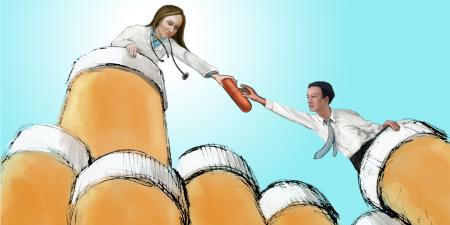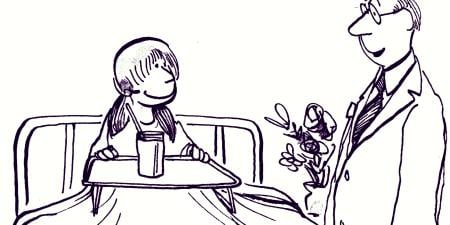Scenario 1: A third-year medical student, eager to help and demonstrate his clinical knowledge in our busy community health center, overstates his ability to understand a patient’s preferred language. He misinterprets her symptoms as well as their severity and timing, and he tells the patient she needs to go to the emergency room. The student reemerges from the room quickly and informs the attending physician of this critical case. When the attending visits the patient to confirm her symptoms, he quickly realizes the student’s mistake and spends several minutes comforting the frightened patient. The patient becomes upset and says she will never agree to receive care from a medical student again. The medical student is greatly embarrassed and hides in the background for the rest of the rotation, doing the minimum necessary to pass and learning little in the process.
Scenario 2: Another third-year medical student sees a similar patient with a panoply of symptoms. As her mind races to understand what possible pathophysiology could explain her patient’s complaints, she realizes that this woman reminds her of an aunt with a type of anxiety disorder specific to her cultural background. The student takes a breath and inquires as to what the patient thinks may be causing her symptoms. The patient hesitates, and then, her eyes fixed directly at her feet, explains that she experienced a great fright last week. The symptoms began after she saw a man being beaten on the street. The student thanks the patient and then describes her findings and diagnosis to the attending physician, and together they devise an appropriate plan of care, including the use of a local healer. The patient is very satisfied and asks the student if she will become her doctor. The student beams and realizes the power and privilege of a strong relationship with patients.
These two scenarios reflect the critical importance of understanding how a patient’s background affects his or her perspective on health. Our center, the University of California, Irvine, is not unique in caring for a multicultural community, and we have seen this community grow and evolve over time. The U.S. population is growing more and more diverse, with ethnic minorities accounting for about 25 percent of the total. If current trends continue, minority groups in the aggregate will make up the majority of the population by 2050. Members of these minority groups in the United States lag behind whites in almost every health indicator, while at the same time having higher rates of acute and chronic disease [1]. These health disparities are attributed to barriers in routine access to preventive care, low levels of efficacy among health professionals in providing culturally sensitive care, and a lack of proportional representation in the health professions [2].
According to the Census 2000 Brief, more than 28 million adults living in the United States speak Spanish as their primary language. Nearly half of this group has limited proficiency in English [3]. Based on census data, the Latino population in California is expected to grow from 10.6 million in 2000 to 21 million in 2025. Meanwhile, in 1999, only 4.8 percent of physicians in California were of Latino descent, creating a ratio of Latino patients to Latino physicians of 2,893:1. The ratio of non-Latino patients to non-Latino physicians in California is 335:1 [4].
The University of California, Irvine, created a comprehensive program to reduce health disparities among Latinos. The Program in Medical Education for the Latino Community (PRIME-LC) is a 5-year, dual-degree program designed to create physician leaders and activists for poor and disenfranchised Latino communities. PRIME-LC scholars complete extra coursework in addition to the regular medical school curriculum, beginning in the summer prior to the first year of medical school. In this busy, 5-week curriculum, students have an immersion experience in Mexico, during which they attend an international conference on health care disparities across borders; accompany Mexican physicians in clinics to help them understand the relationships among patients, physicians, and the health care system in Mexico; and complete the initial class of a 3-course series on health beliefs among Latinos and disparities between health outcomes for Latino and non-Latino populations. These courses are taught by faculty from UCI’s Department of Chicano/Latino Studies and provide students with a different perspective on the significance of social justice in health.
All UCI medical students take a longitudinal course in good patient care featuring small groups and standardized patients. Cases for PRIME-LC Clinical Foundations courses have been altered to reflect issues of culture and health, and all of the patient interviews are conducted in Spanish. During clinical experiences, PRIME-LC students are placed in clinics and hospitals with a high number of Latino patients.
Our students need additional knowledge and skills to realize their potential as physician-activists. To this end, all PRIME-LC students are required to complete a master’s degree program of their choice, as well as a project related to Latino health. We are proud to incorporate PRIME-LC for the first time in graduate medical education, opening a PRIME-LC residency track in the UCI Family Medicine program in 2010.
Although PRIME-LC candidates must have strong track records of involvement with poor communities and speak Spanish competently, it is not an affirmative-action program. Students must be admitted into the general medical school class prior to consideration for acceptance into PRIME-LC, and our 60 students reflect every major ethnic group in California. In attempting to create a network of physician-activists striving to solve a difficult and multifaceted problem, it is invaluable to enlist a diverse group of students. These students complement each other’s skills and serve as teachers to their peers in their particular areas of expertise.
To sustain our effort in PRIME-LC and the larger battle to improve health care for at-risk groups, recruitment must begin much earlier than application to medical school. PRIME-LC seeks to widen existing opportunities for underrepresented minority and disadvantaged students and build new ones. Our students and professors promote health careers in local high schools, and the School of Medicine hosts students from local junior colleges. There are tremendous numbers of talented young people in schools around the United States who just need a chance and someone to show them the way. These are the students who will, upon graduation, return to their communities in need and deliver highly competent health care.
PRIME-LC enrolled its first class in 2001 and celebrated its first graduating class in May 2009. All graduates chose specialties pertinent to poor Latino communities, and all matched with their top-ranked residency programs. At this time, our program is too young to assess our achievement in creating a network of physician leaders that make a difference. We can be proud, however, of the intermediate outcomes we have achieved:
- Focus on social justice and health. PRIME-LC students have performed comparative research on the use of promotoras (lay health workers) in Chiapas, Mexico, and Santa Ana, California. PRIME-LC students have also been integral in the establishment of a student-run free clinic in a village for homeless people 20 minutes from campus. One of the best outcomes of PRIME-LC has been the interaction between the primistas and non-PRIME-LC students. The best elements of PRIME-LC have become a regular part of the general medical school experience, and volunteerism and activism are up in the class as a whole.
- Increased number of students choosing medical specialties with an impact on underserved Latino communities. PRIME-LC students receive special instruction and mentoring to begin careers in family medicine, internal medicine, pediatrics, emergency medicine, obstetrics and gynecology, and psychiatry.
- Increased activism in health policy. PRIME-LC has been a significant influence in resurrecting UCI’s chapter of the American Medical Student Association as an advocacy group, and UCI now sends the largest contingent of medical students in California to Lobby Day, when students meet with California legislators to promote policies that reduce disparities. Some of our students have also completed internships with legislators with a focus on equality in health care. One PRIME-LC student constructed a paid fellowship with Physicians for a National Health Program, and he has now bequeathed this position to a student from the class following his.
Not every medical school setting boasts the resources to begin a program like PRIME-LC. It is amazing, however, what can happen when a dedicated group of faculty and administrators commits to training future physicians for America’s multicultural society. Many of the elements of PRIME-LC can be replicated by emphasizing a conviction toward service and outreach in the regular medical school curriculum. Continuous exposure to positive role models and mentoring can keep motivated students on the right track. These same students can then return to mentor the next generation, a powerful tool that we very much want to use at UCI.
Diversity is a strength of PRIME-LC and one of the greatest sources of strength for our country as a whole. We look forward to the opportunity of improving the well-being of our diverse communities, both through direct medical care and by addressing the roots of health disparities. Our greatest assets in this effort are the physicians and health advocates themselves, and it is our responsibility as health educators to give them every chance to succeed in their mission.
References
- Moy E, Bartman BA. Physician race and care of minority and medically indigent patients. JAMA. 1995;273(19):1515-1520.
-
Smedley BD, Stith AY, Nelson AR; Committee on Understanding and Eliminating Racial and Ethnic Disparities in Health Care. Unequal Treatment: Confronting Racial and Ethnic Disparities in Health Care. Washington, DC: National Academy Press; 2003.
-
Shin HB, Bruno R; US Census Bureau. Language use and English-speaking ability: 2000. 2003. http://www.census.gov/prod/2003pubs/c2kbr-29.pdf. Accessed October 7, 2009.
-
Hayes-Bautista DE, Hsu P, Beltran R, Villagomez J. The Latino physician shortage in California 1999. http://www.cesla.med.ucla.edu/v1/Documents/Reports/shortage.htm?a621a6c71915b50125a63189ade5e8cc=06f897d873a5bbc646e5184aaaff0cb9. Accessed October 7, 2009.



